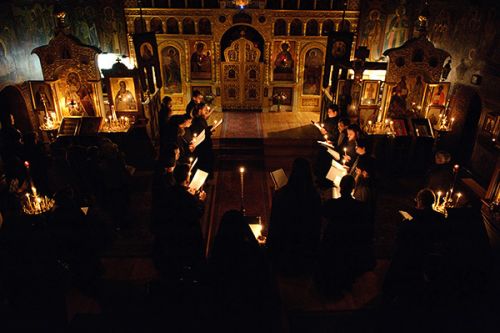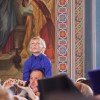Source: St. Vladimir’s Orthodox Theological Seminary
Great Lent allows us each year to rediscover God’s gift of faith and to appreciate that gift with greater feeling, intensity, and understanding. Those aspects of our lives as Orthodox Christians — especially when in church — which have become routine, which perhaps have lost their spiritual relevance in our conscious minds, can during these several Lenten weeks return to a place of significance and importance for us as individuals and as community.
Liturgical music is one such spiritual element that is often taken for granted, perhaps because it is so pervasive in worship — perhaps because it is always there. Indeed, music fills each Orthodox service from beginning to end. In fact, church tradition maintains that basically everything (except the sermon) is sung, from the simplest prayer chanted quietly at the midnight office by candlelight to the most vibrant chorus of “Alleluia” or “Praise the Lord” proclaimed in a cathedral bathed in brilliance. Music, or singing more precisely, is indeed the primary way in which Orthodox Christians liturgically express and communicate their worship and belief.
The temptation, however, is to disconnect liturgical music from the very worship it is meant to express — to hear and discuss it the same way we would any piece of music on the radio or performed in concert. One’s favorite liturgical music setting, in fact, can become nothing more than whatever reflects that person’s tastes and how well the setting has been sung by the cantors or choir. And, over time, taste can begin to determine the shape and sound of liturgical music apart from the actual needs of worship, as if music is merely added on to ornament or decorate worship, even to cover or distract from the “duller” moments. Yet, Great Lent affords us the opportunity to look beyond that temptation and to rediscover liturgical singing as an essential sacred ingredient to Orthodox worship, not as a separate entity added or even imposed on liturgy, but as an organic means of expressing faith in one God, Father, Son, and Holy Spirit.
Consider the following passage written by Orthodox liturgical theologian Alexander Schmemann, taken from his classic work entitled Great Lent. He writes:
It is the worship of the Church that was from the very beginning and still is our entrance into, our communion with, the new life of the Kingdom. It is through her liturgical life that the Church reveals to us something of that which “the ear has not heard, the eye has not seen, and what has not yet entered the heart of man, but which God has prepared for those who love Him.” And in the center of that liturgical life, as its heart and climax, as the sun whose rays penetrate everywhere, stands Pascha. It is the door opened every year into the splendor of Christ’s Kingdom, the foretaste of the eternal joy that awaits us, the glory of the victory which already … fills the whole creation [proclaiming] “death is no more!” The entire worship of the church is organized around Easter, and therefore the liturgical year, i.e., the sequence of seasons and feasts, becomes a journey, a pilgrimage towards Pascha, the End, which at the same time is the Beginning: the end of all that which is “old”; the beginning of the new life, a constant “passage” from “this world” into the Kingdom already revealed in Christ [Great Lent, 13].
Pascha or Easter is therefore the culmination of our liturgical faith. And Fr Schmemann’s words in fact reflect and are justified by exactly what is sung at Paschal Matins. Consider, for instance, among many other examples, the opening verse of the eighth ode of the Paschal canon: “This is the chosen and holy day, first of Sabbaths — king and lord of days. The feast of feasts, holy day of holy days, on this day we bless Christ forevermore.”

Worship, in this sense, is not simply a prescribed religious gathering that happens week after week, where some things change and other things remain the same. It is a cycle, a progression — indeed, a journey. And Great Lent is the season within that journey, by design, that helps remove us from our daily distractions and pre-occupations, as well as from those things which have become routine, and helps us to focus on the elements of the journey itself, so that together we may reach our destination, our Pascha, in one mind and heart.
Yet, how does this specifically relate to church music? The point, as it will continue to unfold in this essay, is that whatever has to do with worship or liturgy also has to do with its music. In other words, the faithful can only truly understand liturgical singing in light of worship, which means also understanding the basic elements of worship itself.
To illuminate the qualities of worship further, one might say that, just as the goal of the Christian year is to arrive at Pascha, the goal of the weekly liturgical cycle is to arrive at the Sunday Resurrectional Eucharist in communion. Indeed, Fr Schmemann for one emphasized this point in his scholarly work. Broken down even further, liturgy is a series or progression of events which, while proclaiming the Gospel, guide the faithful step by step on their journey to meet Christ at the chalice. A scripture reading, for instance, is such an event e.g. the Epistle, an Old Testament reading, the Gospel proclamation. A procession is also an event e.g. marching by candlelight around the church at Pascha, or with Christ’s winding sheet at Holy Friday, or even when the gifts are transferred at the Divine Liturgy from the place of preparation to the altar table. A blessing or consecration is an event e.g. the prayer of the church with the cooperation of the Holy Spirit that consecrates the bread and wine as Christ’s body and blood. And, importantly, each one of these events is either prepared for or accompanied by singing. Liturgical music, therefore, is a key ingredient every time we do something together in worship; music and liturgy are unbreakably linked.
But, not just music or singing. Each event is described, summarized, amplified, or illuminated by text, often poetry such as psalms, troparia, kontakia, canon odes, and the like. These prescribed texts which permeate liturgy can create mental icons of holy events or people who comprise the universal church. Consider the scriptural image painted in the minds of the faithful by the Troparion of the Theophany:
When Thou, O Lord, wast baptized in the Jordan,
The worship of the Trinity was made manifest.
For the voice of the Father bare witness to Thee,
And called Thee His beloved Son.
And the sprit, in the form of a dove,
Confirmed the truthfulness of His word.
And then, to punctuate the recollection and liturgical re-enactment of the event, the closing prayer of the troparion:
O Christ our God, who hast revealed Thyself,
And hast enlightened the world,
Glory to Thee.
This troparion represents, therefore, the central way in which the faithful are to ponder and pray the baptismal commemoration of Christ at the feast of Theophany through the words, images, and references of the text.
A liturgical poem rendered at liturgy can also have instructional dimensions, adding incentive to daily life, such as in this Lenten stanza:
Come, O faithful,
Let us perform the works of God in the Light;
Let us walk honestly as in the day.
Let us rid ourselves of unjust accusations against our neighbors so that we place no stumbling block in their way.
Let us put aside the pleasures of the flesh so that we may increase the grace of our souls.
Let us give bread to those in need.
Let us draw near in repentance to Christ and say:
O our God, have mercy on us …
[Great Lent, 43]
The best writing and sermons offered on the meaning and relevance of Great Lent indeed will reflect precisely the Lenten liturgical theology communicated through texts such as these, which further endeavor to reflect and engage the faithful in scriptural revelation.
All aforementioned examples of events which create the liturgical journey through worship are, as noted, connected to special texts. Epistles, Old Testament readings, and Gospel proclamations are preceded by psalm verses and refrains called prokeimena. The Paschal procession around the church is accompanied by “Thy resurrection, O Christ our Savior…” The funerary procession on Holy Friday is accompanied by “The Noble Joseph” and later by “Holy God.” The gifts are brought to the altar at the Divine Liturgy while the Cherubikon takes place (“Let us who mystically represent…”). And even the consecration of the holy gifts is punctuated by a dialogue in which the celebrant exclaims to God, “Offering you your own of your own, in all things and for all things …” and the congregation completes his phrase with “… we sing to you, we bless you, we give thanks to you … and we pray to you, our God” [based on the Oxford Divine Liturgy translation].
Here, of course, the point regarding music is intensified. All these texts, and numerous others, are written and appointed by tradition to be sung, not recited, in worship. Speech is an essential element of the everyday; without denying its obvious value and potential for eloquence, it is nevertheless routine and quintessentially utilitarian — there is nothing unique or attention grabbing about normal daily speech. Even if the poetic structure of a liturgical text is shaped with a brilliant use of imagery and metaphor, to speak it, in the eyes of tradition, is to give the aural impression that the text is common or ordinary. And the same text is perhaps only slightly enhanced if it is read instead by someone with an attractive resonant voice. Yet, text set to music is an undeniably elevated form of expression — arguably the highest form of textual expression in fact. To sing rather than speak sacred text emphasizes that the realm of the liturgical is an unmistakably special place which yields a heightened experience, never mundane or commonplace.
As well, singing, better than speech, engages a collection of individuals and unifies them into the heightened activity of producing melody and rhythm to sacred words. This is why the early Byzantine church emphasized congregational participation in responsorial psalmody. There is a collective momentum and energy in singing, precisely because of pitch and rhythmic organization, that lacks in spoken group recitation. In fact, when a group speaks a text together, the words most often become heavy and stilted i.e. artificially dignified or pompous even, the phrasing becomes contrived, and nuance caves into the blandness of solemn oath-like recitation. In singing, however, text is enlivened by melody and pulse, ensuring flow and direction, thus arguably engaging the senses more fully. In fact, whether the faithful are actually singing sacred text or listening to the words and music produced by the cantors or choir, those gathered should be drawn into the text being sung — into its theme and essence, and the music should likewise direct the faithful to the sacred liturgical event taking place or about to take place. If, on the other hand, music or singing muddies the text, or in some way distracts from liturgy, commanding attention to itself and away from worship, then it fails to fulfill its purpose or liturgical raison d’кtre. One could say, in the end, that it becomes in these instances nothing more than religious entertainment. Thus, sadly, the failure to take the broadest level of liturgical consideration into account first and foremost while examining the actual music tempts clergy, scholars, church musicians, and parishioners alike to focus on the purely musical aspects of liturgical music to the detriment and sometimes complete ignorance of the liturgical aspects.
Great Lent, for instance, is not simply a season during which, from a musical point of view, special melodies and settings are sung in church. But, it is precisely the presence of these unique melodies and settings that should also signal and engage the presence of special Lenten texts and themes, and should furthermore draw greater attention to the sacred acts or events which move the faithful on their Paschal journey. Therefore, to say that music or singing is the primary way in which Orthodox Christians express their liturgical faith and belief is not figurative or symbolic rhetoric, but a literal reflection and acknowledgment of the artistic mechanism by which worship elevates as it comes to life. And merely singing appointed texts at appointed times does not guarantee the engagement of the faithful. The way in which a setting is composed to deliver text and the manner in which it is sung to spotlight the liturgical event becomes paramount. For instance, as the congregation makes the Holy Friday procession by candlelight, the accompanying setting of “Holy God” should not only clarify the words, but be compositionally constructed in such a meter and melodic format so as to help move the congregation forward, gently, on their liturgical pilgrimage to Christ’s tomb. The music, in other words, must be written and sung to cater to the text and the event.
The actual style of singing used to elevate liturgy has varied greatly over history and from culture to culture, even region to region. Little can be authoritatively determined about the sound of singing in the early Byzantine church. Ancient sources or manuscripts lead us to believe that, at the beginning of the second Christian millennium, Byzantine chant was monophonic, tuneful, straight-forward, and generally syllabic. Soon after a drone-like addition to the chant (called “ison”), which supplied a tonal reference point for the melody, was documented in the singing books. Early Slavic chant, which evolved from Byzantine chant after 988 AD, followed suit (probably without the ison, though some reputable scholars contend there was an ison present in certain Slavic religious centers). Both Byzantine and Slavic chant began to expand into complex forms of musical expression after the twelfth century. For the Byzantine church, the kalophonic style of intensively melismatic singing i.e. several notes over one syllable evolved. Znamenny chant for the Slavs also became melismatic through a contrasting melodic system, and eventually developed by the seventeenth century into indigenous polyphony. The Slavs then took off on a different path altogether, embracing at the court of St. Petersburg various forms of Western-influenced polyphony. This style manifested itself in motet-like singing, followed by Italian schooled polyphony and harmony in the eighteenth century and Germanic harmonic influence in the nineteenth century, culminating in a unique style of chant harmonization in Moscow through composers such as Smolensky and Kastalsky.
Twentieth century North America combines several traditions and new styles of Orthodox music, sometimes even within the same parish community. Choral singing in various forms associated with western music seems to reign, although historical modal chant from the Byzantine tradition is noticeably on the rise. Some church musicians are also searching for a uniquely American form of Orthodox liturgical music expression, drawing on the prevailing tastes of modern culture — as complex and contrasting as those tastes are — to inform and characterize music for worship. Arguments over musical style also seem to be escalating and causing some divisiveness among the Orthodox, especially within their own jurisdictions. These arguments include the role of musical instruments in worship as well as tonal versus modal singing.
These debates and competitions on musical style are fruitless if not placed before the following aforementioned liturgical standard: a musical setting should enliven and clearly express the text to which it is set and simultaneously engage the faithful in the sacred liturgical event which is taking place or about to take place. Whatever style of well-crafted music achieves this, from monody to polyphony to harmony and so on, can be considered legitimately liturgical and worthy of consideration. The same standard can be used to measure the validity of introducing into Orthodoxy non-singing musical elements, i.e. instruments (especially organs), as has been done in some churches in North America. The fact that instruments are incapable of communicating words — but only sounds to be individually interpreted — creates the first stumbling-block. The ability or inability of these instruments furthermore to be used to enhance the vocal delivery of sacred text and to draw the faithful into worship beyond the capabilities of singing per se is truly the ground on which this topic should be debated. Whatever the issues and their complexities, perhaps we can agree that music for worship, validated by centuries of tradition, must serve liturgical purpose i.e. it must be liturgical for it to be music. And how that actually occurs in worship requires extensive training, contemplation, and liturgical sensitivity.
In conclusion, a Lenten look at liturgical music allows us, as a first step, to rediscover the central and critical role singing plays at each liturgical gathering. The beauty of the singing is not only in the actual notes, rhythms, and voices, but extends to the way in which it enlivens and elevates prayer and enables us to travel by one liturgical event to the next, reaching Christ at His chalice and in triumph at His Pascha. Only because our tradition relies on music as a key form of expression can we actually sing the following Lenten verse:
The time of Lent is a time of gladness!
With radiant purity and pure love,
Filled with resplendent prayer and all good things,
Let us sing with joy. …
This essay is a re-shaping and amplification of remarks make during Mark Bailey’s presentation entitled “Lenten Encounters in Liturgical Music,” delivered on 18 March 1999 at the Holy Trinity Greek Archdiocesan Cathedral in New York City. Participants heard samples of traditional Orthodox liturgical music and sang several Lenten and non-Lenten musical settings.















